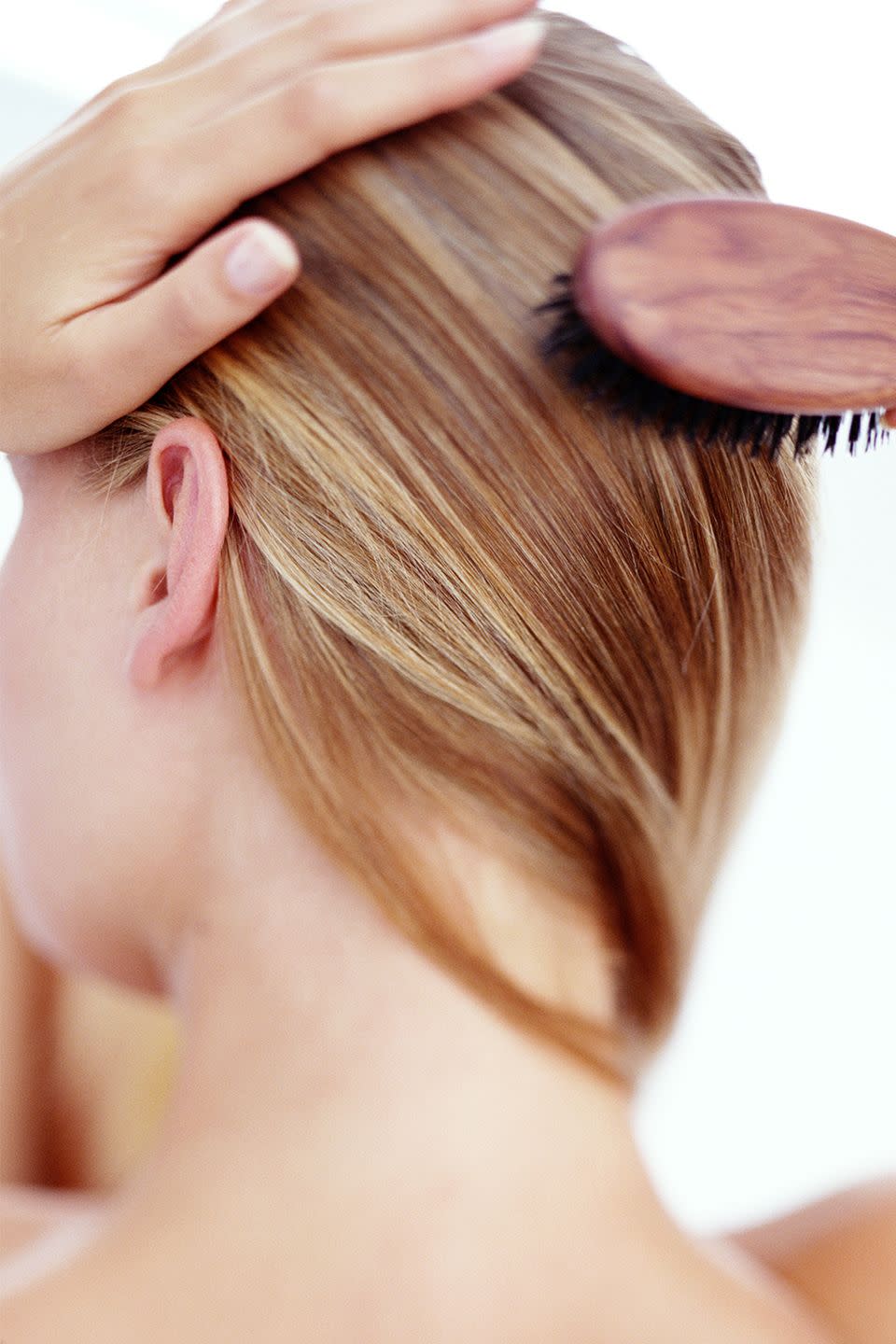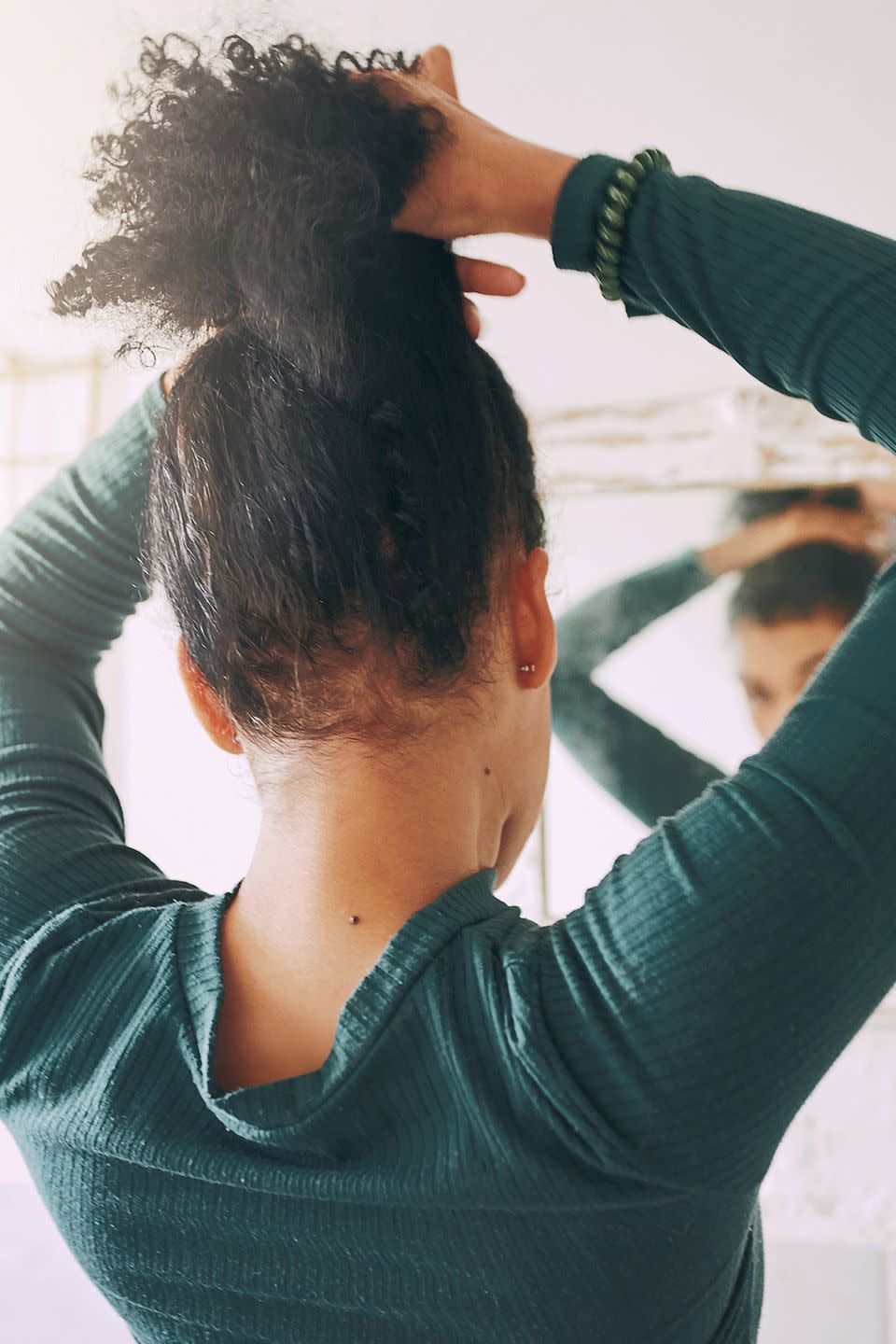Yes, You Can *Actually* Treat Your Receding Hairline—Here's How
“Hearst Magazines and Verizon Media may earn commission or revenue on some items through the links below.”
Ready for the biggest understatement of all time? Dealing with any form of hair loss or thinning is beyond frustrating (I’m talking from experience here, ppl). But if you think you have a receding hairline, you need to know two things: (1) You’re far from alone—it’s seriously common and can happen to people of all ages—and (2) you actually have a handful of treatment options that can help beef up your strands if/when you want to. Ahead, I spoke with a handful of experts in the hair-loss field to get the lowdown on receding hairlines, including what causes them, how exactly to treat them, and more. Let’s get right into it, shall we?
How do I tell if my hairline is receding?
Before I get into the nitty-gritty, let’s begin with the basics—like, for starters, what a receding hairline even is. According to Flordia-based trichologist Bridgette Hill, aka the @TheScalpTherapist, a receding hairline refers to when the front hair follicles miniaturize (or thin out) and eventually become dormant to the point that the hairline moves farther away from the face.

“The amount of hair follicles around the hairline and the shape of the hairline itself is a predisposition based on our genetic makeup,” says Hill. “Receding hairlines can be determined by changes in the density of hair around the face, not to be confused with shorter broken hairs around the hairline.”
Marisa Garshick, MD, a dermatologist in New York City, says patients are usually pretty quick to identify hairline recession on their own, since unlike more hidden areas (like, say, the nape of the neck), it’s a visible spot that we see every day when we look in the mirror. The most prominent sign? More skin showing on the frontal scalp (i.e., that spot where your forehead meets your scalp). “When you have that decreased hair density, it can also give the appearance of a higher forehead,” she says.
But even though receding hairlines are relatively easy to identify, Dr. Garshick says it’s still a good idea to get a scalp biopsy, since having a professional look closely at the hair follicles will give you a better sense of what type of hair thinning you’re dealing with. “Sometimes blood work can also help to determine if there’s a hormonal trigger, or if the hair loss is related to any other medical condition,” she explains. The bottom line? If you think your hairline is receding, book an appointment with a dermatologist or certified trichologist before you jump to any conclusions.
What causes a receding hairline?
K, I know you’re hoping for a cut and dry answer here, but it’s a bit more complicated than that. Take it from Hill, who says there are quite a few factors that can cause receding hairlines in women. “Thinning along the hairline or temples is more than likely the result of either traction alopecia, excessive hairstyling habits, genetic hair loss, or frontal fibrosing, which is a form of lichen planopilaris, an autoimmune disease that triggers scarring alopecia,” she explains.
Hill says that while more research needs to be done in order to understand the specific root causes of receding hairlines, we definitely know that factors like genetics, overall health, hormones, diet, medications, and styling habits all come into play (which, again, is why it’s so important to visit an expert to help get to the bottom of your hair loss and growth).
It’s also worth noting that receding hairlines are not caused by telogen effluvium, aka hair loss triggered by stressful events (think: a hospitalization or, IDK, a global pandemic) as well as certain medications and medical conditions (including anorexia, thyroid disorders, iron deficiency, and more). “With telogen effluvium, hairs fall out all over the head in a pretty significant fashion, so it doesn’t just present as a receding hairline,” says dermatologist, Robert Finney, MD. “In genetic hair loss, however, the density slowly thins, sometimes giving the appearance of a receding hairline in certain patterns.”
All of this is to say that there are a ton of reasons why your hairline might be receding, so it’s always in your best interest to see an expert to determine what’s really going on.
What’s the difference between receding and thinning hair?
Good news, folks: The answer to this one is pretty straightforward. According to Hill, it all comes down to the reduction of hair fibers versus actual hair follicles. “With a thinning hairline, it’s a reduction of hair fibers in each hair follicle, which creates the appearance of less density,” she says. “But with receding, it’s a reduction of actual hair follicles that become dormant and die off, leading to a higher hairline and the forehead becoming more obvious.” Dr. Garshick adds that while thinning may occur diffusely around the whole scalp, a receding hairline typically refers to decreased density of hair primarily involving the frontal scalp.
Can a receding hairline grow back?

This one really depends on the cause, says Dr. Finney, but it is possible in some cases. “The best chance to regrow hair is with early intervention,” he says. “The longer someone waits, the less of a likelihood they have to regrow their hair, so we then shift the focus to maintenance.” Dr. Garshick has a similar point of view. “Often when we initiate treatment for a receding hairline, our goal is to prevent worsening, but if we are able to see hair grow back, then of course that’s even better,” she explains.
Additionally, Hill says it really depends on if the follicle is dormant or not. “If there’s a dormant follicle with blood flow, there’s a strong possibility that the hairline will improve and more hairs will come back,” she adds. “But if the follicle is no longer thriving and is dying off, there is no way to revive the follicle.” And I know I’m sounding like a broken record here, but getting a scalp analysis from a certified professional is the best way to figure out what’s possible for your hairline.
How do you treat a receding hairline?
While everyone is different, many experts prefer to take a multi-pronged approach when it comes to treating a receding hairline—and that includes focusing on consistency and maintenance if you want to see real and lasting results. That means trying both in-office treatments and a disciplined at-home regimen, says Hill. Your doctor or trichologist will be able to create a specific plan of action for your hair loss, which will generally include a combination of the following treatments:
1. OTC options
One of the main over-the-counter options you can find at many drugstores is minoxidil, though it’s typically more potent in prescription form (more on that in a sec). Dr. Garshick also commonly recommends Nioxin for those with thinning hair and frontal recession, which helps thicken the hair with proteins, amino acids, and antioxidants.
2. Prescription medications
According to Dr. Finney, some doctors will create a customized prescription topical made up of minoxidil, spironolactone, and bimatoprost, as it’s stronger than over-the-counter minoxidil. Spironolactone works by reducing the production of androgen hormones, which helps to slow down the progression of hair loss caused by androgenic alopecia. On top of that, it’s also shown to encourage new growth, especially when coupled with minoxidil, which is thought to work by widening blood vessels so that more oxygen-rich blood can reach the hair follicles.
Other prescription options include Propecia or finasteride, as well as dutasteride. “In general, these medications are thought to block androgens, though the specific mechanism may vary among the medications and whether it’s intended to help with hormonally triggered hair loss,” says Dr. Garshick. “These medications should be discussed with a board-certified dermatologist to determine if you are a good candidate.”
3. Laser therapy
You’ll often find low-level light laser therapy in the form of caps or helmet-like devices, like the iRestore Laser Pro, which has been approved by the FDA. This non-invasive treatment option uses laser light to stimulate cell growth and supercharge the hair follicles, which can lead to thicker hair over time.
4. Platelet rich plasma
Also known as PRP, this popular treatment involves getting your blood drawn and having it spun down to obtain PRR, which as Dr. Garshick explains, are rich in growth factors that may help promote regrowth. “Because it does not work for all types of hair loss, it is important to check with your dermatologist to determine if this is an option for you,” she says.
5. Nutraceuticals
This includes supplements such as Viviscal and Nutrafol, both of which are very popular among women with hair loss. “Nutrafol is a supplement to help support hair growth as it contains a Synergen complex which includes a combination of anti-stress adaptogens, antioxidants, anti-inflammatory, and DHT-blocking ingredients like saw palmetto, ashwagandha, curcumin, and tocotrienol,” says Dr. Garshick. “Studies showed that 86 percent of women noticed improved hair growth, 84 percent noticed stronger and thicker hair, and 75 percent noticed reduced shedding with continued use.”
Viviscal, on the other hand, is made up of what’s called an AminoMar marine complex. “Clinical studies have shown a 75 percent reduction in hair loss and they also offer shampoo and conditioners as part of their system to help volumize and support the hair-growth process,” says Dr. Garshick.
6. Hair transplants
Hair transplantation is a surgery that involves removing hair follicles from one part of the body—called the “donor site”—to a bald or thinning area of the body known as the “recipient site” (which, with receding hairlines, is the frontal scalp). People typically notice new growth after a few months and see great results, but it’s definitely up there with the pricier treatment options (you can expect this surgery to cost thousands of dollars).
7. Scalp brushing
“I encourage clients to activate the scalp muscles and improve circulation by massaging the scalp,” says Hill. “The right scalp brush will enhance this experience and remove debris from the base of the hair follicle and loosen any buildup from the scalp so that it can be properly removed during the shampooing process.” Ultimately, keeping the scalp healthy and encouraging blood flow can help with regrowth in some cases.
The final word
While dealing with a receding hairline is far from fun, it’s important to remember that it's common and possible to treat—so long as you hop on top of it early and see a professional for help with determining the right treatment plan for you. The bottom line: Don’t drive yourself nuts over a receding hairline. It happens to the best of us, largely as a result of genetics, but it can be improved through some simple measures like scalp brushing, as well as OTC products, medications, and procedures under the guidance of a dermatologist.
You Might Also Like

